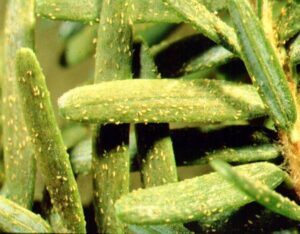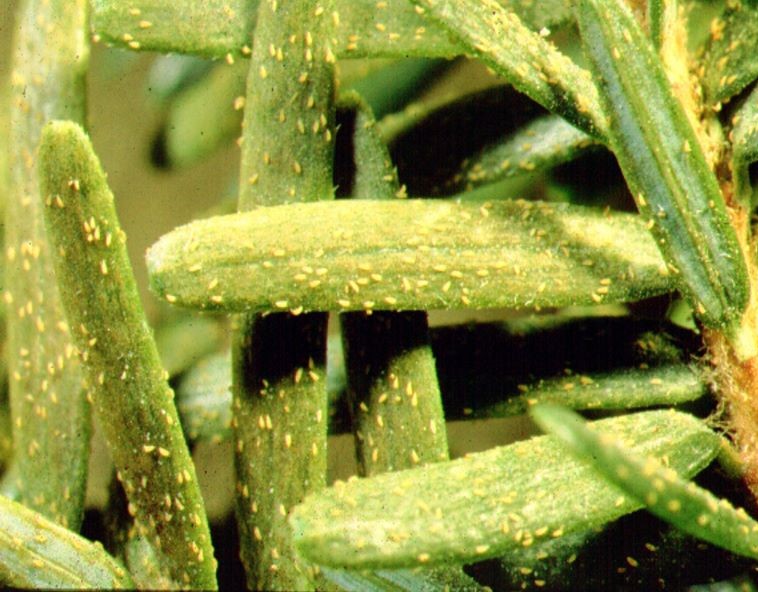Hemlock Rust Mite (Nalepella tsugifoliae)
GDD Window (base 50): 7-450 (7-22: active mites emerge)
Overview:
- Tiny, wormlike insects that require magnification to be seen
- In the spring, scout using a 10x hand lens
- Adult mites are yellow and spindle-shaped with four legs
- Thin, white colored cast skins may be visible with magnification
- Tiny, yellowish-orange eggs
- Overwintering eggs are reddish to tan, laid in clusters
- Adults overwinter in the cracks of bark
- Feed on needles of hosts year round
- Feed by injecting saliva and sucking out plant juice
- Tiny pale spot forms at each feeding puncture
- Causes most of its damage in the spring, and damage becomes most noticeable by mid-summer
- By that time, populations die off
- Foliage may appear blue-ish and turn yellow before dropping from the plant
- Populations thrive in cool and dry conditions
- Host plants: Fir, Golden larch, Hemlock, Spruce, Yew
Management:
Cultural Practices:
- Natural predators: predatory mites, lady beetles, lacewings, Hirsutella thompsonii (parasitic fungus)
- Prune out and destroy individual, infested branches when possible
Materials:
- Contact insecticides:
- Pyrethroids [3]: Pyrethrin
- Pyrethrins [3+Synergist]: Pyrethrin + piperonyl butoxide
- Avermectins [6]: Abamectin
- Carbamate [1A]: Carbaryl
- Mito. Compx III [20D]: Bifenazate
- Systemic insecticides:
- Tetronics [23]: Spirotetramat
- Considerations:
- Pyrethroids and carbamates will harm beneficial predators if present.
Biorationals:
- MGI [10A]: Clofentezine
- MGI [10B]: Etoxazole
- Horticultural oil (neem oil)
- Apply 7-10 days before bud break and again at bud break to target eriophyid mites and avoid impact on beneficial insects.Test for phytotoxicity before spraying the whole plant.


Disclaimer – Materials do not cover all possible control scenarios and are intended for licensed professionals. Tradenames do not imply endorsement and are used as examples. You must strictly follow the label for each compound prior to use. Rutgers is not responsible form is used materials or damages thereof. The label is the law. Labels will provide detailed information on use and restrictions. Additionally, application intervals, compatibility, surfactant use, PHI, PPE, important and other key information is described in detail. Always discuss treatments with your local agents. Note: Neonicotinoids can only be legally applied in commercial agriculture settings by licensed applicators. Guidelines and recommendations made in this presentation are specific to the state of New Jersey.
